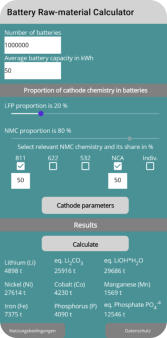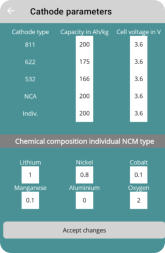The
second
level
offers
you
the
possibility
to
define
some
parameters
of
the
NMC
cathode material yourself.
In
the
upper
part
you
can
set
the
specific
capacity
and
the
cell
voltage
for
the
specified
cell chemistry. From this data, the app calculates the energy of the material in Wh/kg.
If
you
want
to
have
an
individual
cell
chemistry
calculated,
you
can
first
enter
the
capa
-
city
and
the
cell
voltage.
You
can
then
define
the
exact
empirical
formula
of
your
material.
Make
sure
that
the
empirical
formula
is
correct,
the
program
does
not
check
your values for plausibility.
By clicking on the "Accept changes" button
,
your
entered
values
will
be
included
in
the calculation.
For
the
subsequent
calculation
of
the
quantities,
you
must
now
click
the
"Calculate"
but
-
ton again on the first level.
To
give
you
an
example
of
how
to
enter
the
values,
the
values
for
an
NMC811
(LiNi0.8Mn0.1Co0.1O2)
are
stored
in
the
image
on
the
left.
Here
you
can
play
with
the
composition. But beware, the program does not check whether your entries make sense!
You
can
find
information
on
the
common
parameters
for
the
materials
via
the
common
search engines, scientific literature or in published patents.
The
calculation
of
the
material
requirements
for
lithium-ion
batteries
starts
with
specify
-
ing
the
number
of
batteries.
You
enter
the
number
of
batteries
yourself,
you
can
start
with
just
one
cell.
In
the
next
field
you
have
to
enter
the
average
battery
capacity
in
kWh.
This average should also be able to cover a possible mix of materials.
In
the
next
step
you
can
give
an
estimation
of
the
respective
proportions
of
LFP
(LiFePO4)
and
NMC
in
the
total
amount.
However,
you
can
do
without
a
division
between
the
two
technologies
and,
for
example,
only
accept
100%
LFP
chemistry
or
100%
NMC
chemistry.
However,
it
is
also
possible
to
specify
any
market
share
of
LFP
and
NMC
cells
using
a
slider.
Don't
be
surprised
that
only
the
LFP
slider
is
movable.
The
slider
for
NMC
automatically adapts to 100% in the sum of the two.
You
can
now
further
define
the
NMC
chemistry
and
specify
its
shares.
You
also
have
the
option of specifying an individual composition and its proportion of the cells.
Since
some
cathode
parameters
are
set
arbitrarily,
you
can
already
come
to
a
result
that
is calculated using the "Calculate" button
in the lower part of the page.
Depending
on
which
battery
quantities
you
have
defined
above,
the
units
of
the
required
material
quantities
adapt
(automatically
from
grams
to
tons).
So
pay
attention
to
the
units of measure you are in.
As
an
alternative
to
using
the
arbitrarily
set
cathode
parameters,
you
can
precisely
define
some parameters yourself. By clicking the "Cathode parameters" button
click to go to level 2.
Description of levels
Level 1: Definition of general conditions
Level 2: Definition of Cathode Parameters


1

1

2

2


1

1
Description of levels
Prismatic cell




1

2
The
calculation
of
the
material
requirements
for
lithium-ion
bat
-
teries
starts
with
specifying
the
number
of
batteries.
You
enter
the
number
of
batteries
yourself,
you
can
start
with
just
one
cell.
In
the
next
field
you
have
to
enter
the
average
battery
capa
-
city
in
kWh.
This
average
should
also
be
able
to
cover
a
possible
mix of materials.
The
second
level
offers
you
the
possibility
to
define
some
para
-
meters
of
the
NMC
cathode
material yourself.
In
the
upper
part
you
can
set
the
specific
capacity
and
the
cell
voltage
for
the
specified
cell
chemistry.
From
this
data,
the
app
calculates
the
energy
of
the material in Wh/kg.

1

2

1


1
In
the
next
step
you
can
give
an
estimation
of
the
respective
proportions
of
LFP
(LiFePO4)
and
NMC
in
the
total
amount.
However,
you
can
do
without
a
division
between
the
two
technologies
and,
for
example,
only
accept
100%
LFP
che
-
mistry
or
100%
NMC
chemistry.
However,
it
is
also
possible
to
specify
any
market
share
of
LFP
and
NMC
cells
using
a
sli
-
der.
Don't
be
surprised
that
only
the
LFP
slider
is
movable.
The
slider
for
NMC
automatically
adapts
to
100%
in
the
sum
of the two.
You
can
now
further
define
the
NMC
chemistry
and
specify
its
shares.
You
also
have
the
option
of
specifying
an
indivi
-
dual composition and its proportion of the cells.
Since
some
cathode
parameters
are
set
arbitrarily,
you
can
already
come
to
a
result
that
is
calculated
using
the
"Calcu
-
late" button
in the lower part of the page.
Depending
on
which
battery
quantities
you
have
defined
above,
the
units
of
the
required
material
quantities
adapt
(automatically
from
grams
to
tons).
So
pay
attention
to
the
units of measure you are in.
As
an
alternative
to
using
the
arbitrarily
set
cathode
parame
-
ters,
you
can
precisely
define
some
parameters
yourself.
By
clicking the "Cathode parameters" button
click
to
go
to
level 2.
If
you
want
to
have
an
individual
cell
chemistry
calculated,
you
can
first
enter
the
capacity
and
the
cell
voltage.
You
can
then
define
the
exact
empirical
formula
of
your
material.
Make
sure
that
the
empirical
formula
is
correct,
the
program
does not check your values for plausibility.
By clicking on the "Accept changes" button
,
your
ente
-
red values will be included in the calculation.
For
the
subsequent
calculation
of
the
quantities,
you
must
now click the "Calculate" button again on the first level.
To
give
you
an
example
of
how
to
enter
the
values,
the
values
for
an
NMC811
(LiNi0.8Mn0.1Co0.1O2)
are
stored
in
the
image
on
the
left.
Here
you
can
play
with
the
composition.
But
beware,
the
program
does
not
check
whether
your
entries
make sense!
You
can
find
information
on
the
common
parameters
for
the
materials
via
the
common
search
engines,
scientific
litera
-
ture or in published patents.








